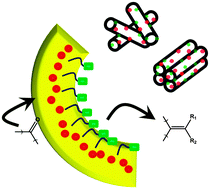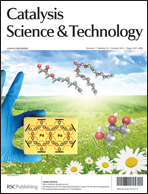Designing bifunctional acid–base mesoporous hybrid catalysts for cascade reactions†
Abstract
Bifunctional mesoporous hybrid materials, containing both proton sponges and acid groups, have been prepared following different synthetic routes: co-condensation processes (sol–gel or micellar one-pot routes) or post-synthetic grafting of the organic functionalities. 1,8-Bis(dimethylamino)naphthalene (DMAN), a proton sponge with high pKa, was used as an organic functional builder base and 3-mercaptopropyltriethoxysilane (MPTES) as a pendant precursor of sulfonic acids. The bifunctional hybrid materials were extensively characterized and were investigated as heterogeneous catalysts for various one-pot C–C bond-forming cascade reactions such as deacetalization–Knoevenagel condensation or deacetalization–nitroaldol (Henry) reaction.


 Please wait while we load your content...
Please wait while we load your content...